University Workplace Management and Leadership Report Analysis
VerifiedAdded on 2023/01/20
|8
|1701
|63
Report
AI Summary
This report provides a comprehensive overview of workplace management, focusing on key aspects such as efficiency, communication, and resource management. It delves into an extended model of the management process, including internal organizational environments, resources, and their impact on overall performance. The report also explores effective communication strategies, group moderation techniques, and the role of budgeting and planning in decision-making processes. Furthermore, it examines performance management systems, leadership theories, and their practical applications within the workplace, including trait and behavioral theories. The report also includes references to relevant academic sources.
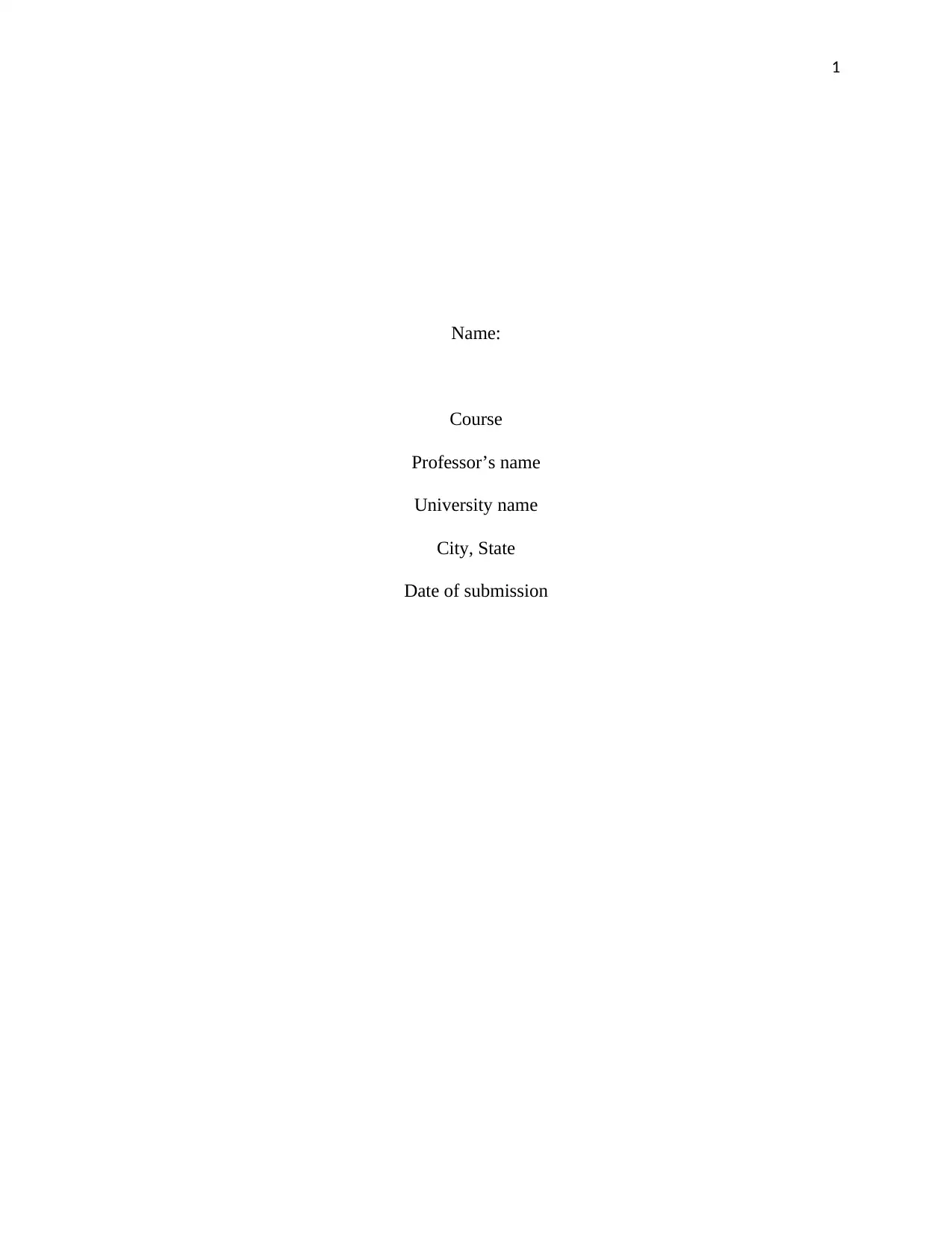
1
Name:
Course
Professor’s name
University name
City, State
Date of submission
Name:
Course
Professor’s name
University name
City, State
Date of submission
Paraphrase This Document
Need a fresh take? Get an instant paraphrase of this document with our AI Paraphraser
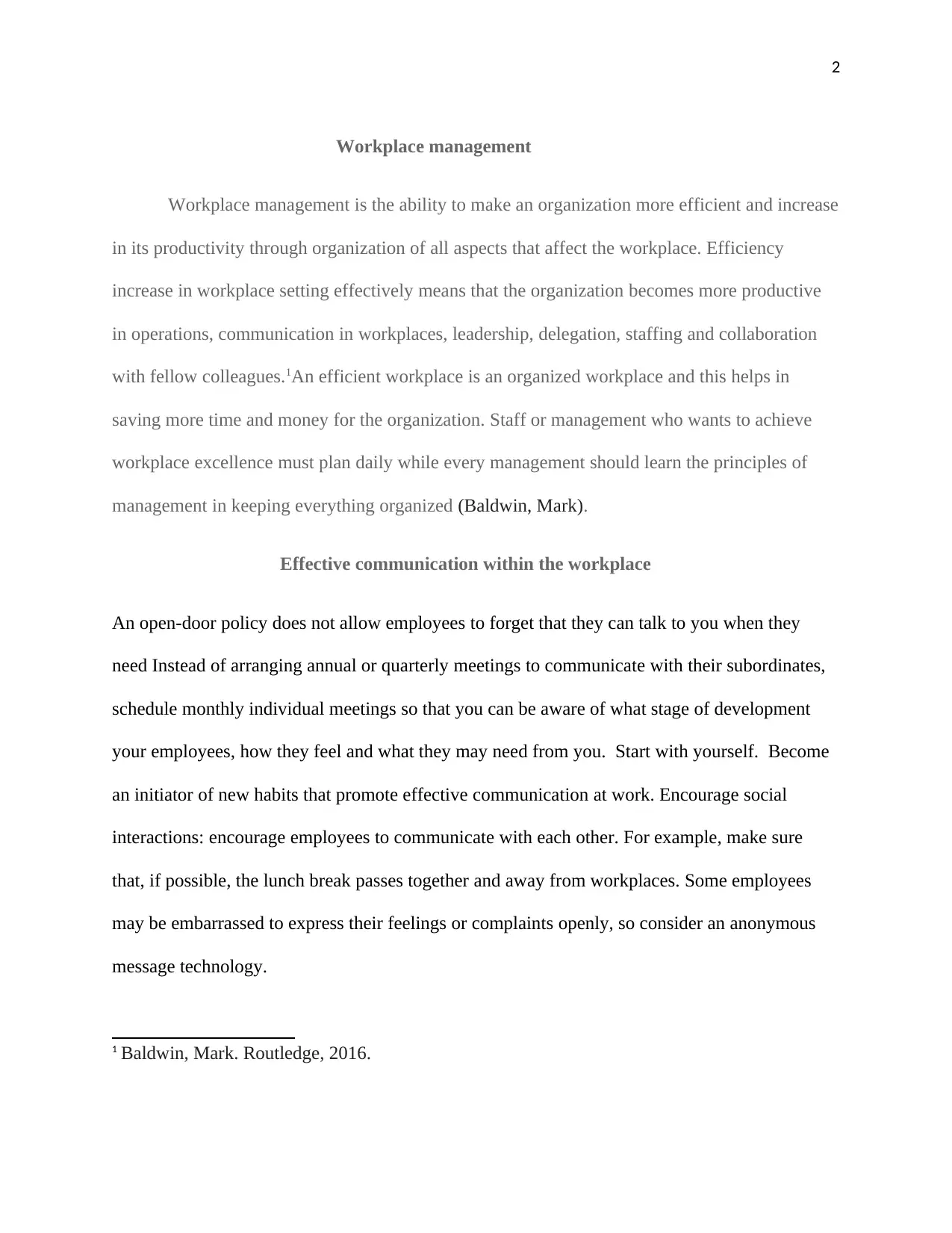
2
Workplace management
Workplace management is the ability to make an organization more efficient and increase
in its productivity through organization of all aspects that affect the workplace. Efficiency
increase in workplace setting effectively means that the organization becomes more productive
in operations, communication in workplaces, leadership, delegation, staffing and collaboration
with fellow colleagues.1An efficient workplace is an organized workplace and this helps in
saving more time and money for the organization. Staff or management who wants to achieve
workplace excellence must plan daily while every management should learn the principles of
management in keeping everything organized (Baldwin, Mark).
Effective communication within the workplace
An open-door policy does not allow employees to forget that they can talk to you when they
need Instead of arranging annual or quarterly meetings to communicate with their subordinates,
schedule monthly individual meetings so that you can be aware of what stage of development
your employees, how they feel and what they may need from you. Start with yourself. Become
an initiator of new habits that promote effective communication at work. Encourage social
interactions: encourage employees to communicate with each other. For example, make sure
that, if possible, the lunch break passes together and away from workplaces. Some employees
may be embarrassed to express their feelings or complaints openly, so consider an anonymous
message technology.
1 Baldwin, Mark. Routledge, 2016.
Workplace management
Workplace management is the ability to make an organization more efficient and increase
in its productivity through organization of all aspects that affect the workplace. Efficiency
increase in workplace setting effectively means that the organization becomes more productive
in operations, communication in workplaces, leadership, delegation, staffing and collaboration
with fellow colleagues.1An efficient workplace is an organized workplace and this helps in
saving more time and money for the organization. Staff or management who wants to achieve
workplace excellence must plan daily while every management should learn the principles of
management in keeping everything organized (Baldwin, Mark).
Effective communication within the workplace
An open-door policy does not allow employees to forget that they can talk to you when they
need Instead of arranging annual or quarterly meetings to communicate with their subordinates,
schedule monthly individual meetings so that you can be aware of what stage of development
your employees, how they feel and what they may need from you. Start with yourself. Become
an initiator of new habits that promote effective communication at work. Encourage social
interactions: encourage employees to communicate with each other. For example, make sure
that, if possible, the lunch break passes together and away from workplaces. Some employees
may be embarrassed to express their feelings or complaints openly, so consider an anonymous
message technology.
1 Baldwin, Mark. Routledge, 2016.
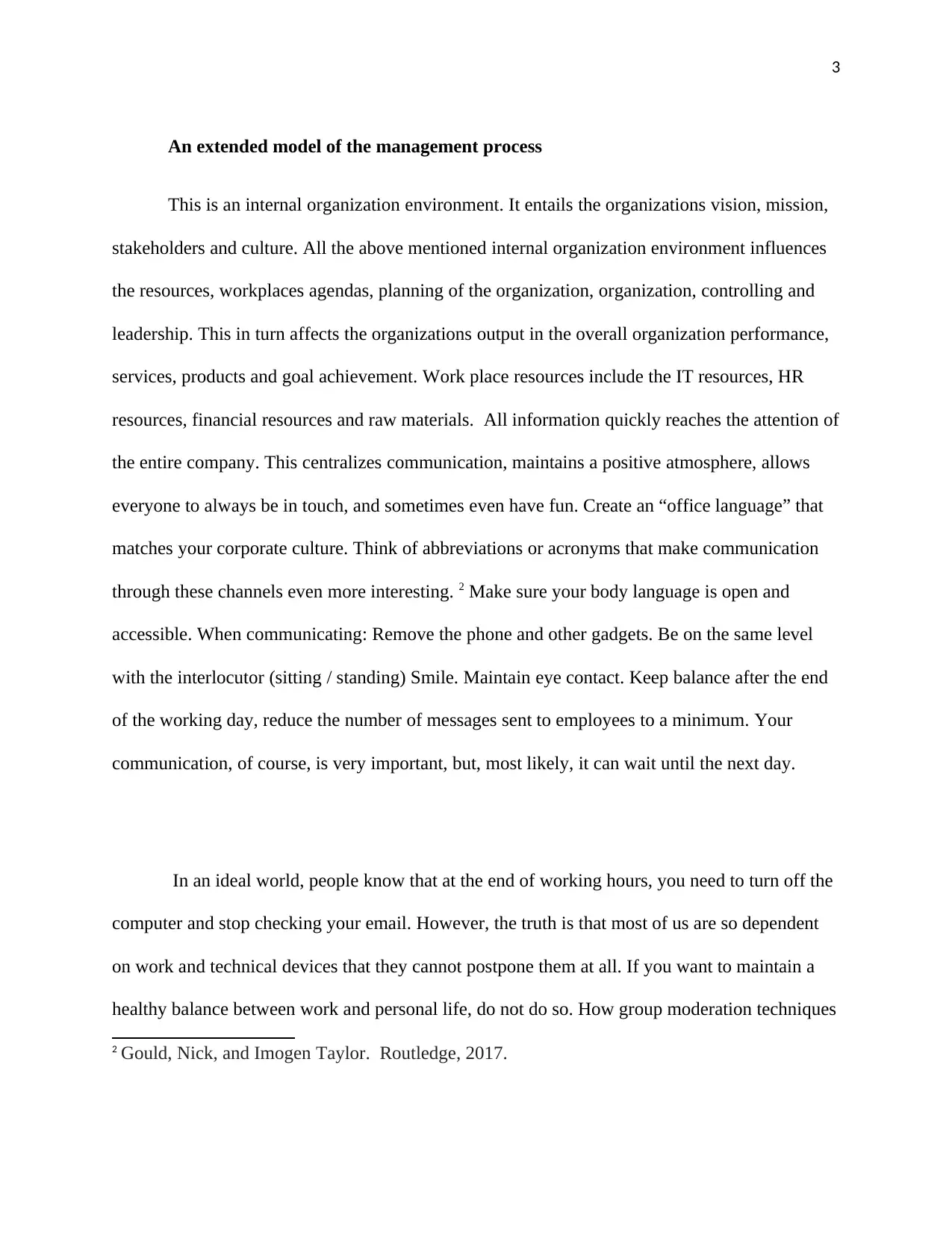
3
An extended model of the management process
This is an internal organization environment. It entails the organizations vision, mission,
stakeholders and culture. All the above mentioned internal organization environment influences
the resources, workplaces agendas, planning of the organization, organization, controlling and
leadership. This in turn affects the organizations output in the overall organization performance,
services, products and goal achievement. Work place resources include the IT resources, HR
resources, financial resources and raw materials. All information quickly reaches the attention of
the entire company. This centralizes communication, maintains a positive atmosphere, allows
everyone to always be in touch, and sometimes even have fun. Create an “office language” that
matches your corporate culture. Think of abbreviations or acronyms that make communication
through these channels even more interesting. 2 Make sure your body language is open and
accessible. When communicating: Remove the phone and other gadgets. Be on the same level
with the interlocutor (sitting / standing) Smile. Maintain eye contact. Keep balance after the end
of the working day, reduce the number of messages sent to employees to a minimum. Your
communication, of course, is very important, but, most likely, it can wait until the next day.
In an ideal world, people know that at the end of working hours, you need to turn off the
computer and stop checking your email. However, the truth is that most of us are so dependent
on work and technical devices that they cannot postpone them at all. If you want to maintain a
healthy balance between work and personal life, do not do so. How group moderation techniques
2 Gould, Nick, and Imogen Taylor. Routledge, 2017.
An extended model of the management process
This is an internal organization environment. It entails the organizations vision, mission,
stakeholders and culture. All the above mentioned internal organization environment influences
the resources, workplaces agendas, planning of the organization, organization, controlling and
leadership. This in turn affects the organizations output in the overall organization performance,
services, products and goal achievement. Work place resources include the IT resources, HR
resources, financial resources and raw materials. All information quickly reaches the attention of
the entire company. This centralizes communication, maintains a positive atmosphere, allows
everyone to always be in touch, and sometimes even have fun. Create an “office language” that
matches your corporate culture. Think of abbreviations or acronyms that make communication
through these channels even more interesting. 2 Make sure your body language is open and
accessible. When communicating: Remove the phone and other gadgets. Be on the same level
with the interlocutor (sitting / standing) Smile. Maintain eye contact. Keep balance after the end
of the working day, reduce the number of messages sent to employees to a minimum. Your
communication, of course, is very important, but, most likely, it can wait until the next day.
In an ideal world, people know that at the end of working hours, you need to turn off the
computer and stop checking your email. However, the truth is that most of us are so dependent
on work and technical devices that they cannot postpone them at all. If you want to maintain a
healthy balance between work and personal life, do not do so. How group moderation techniques
2 Gould, Nick, and Imogen Taylor. Routledge, 2017.
⊘ This is a preview!⊘
Do you want full access?
Subscribe today to unlock all pages.

Trusted by 1+ million students worldwide
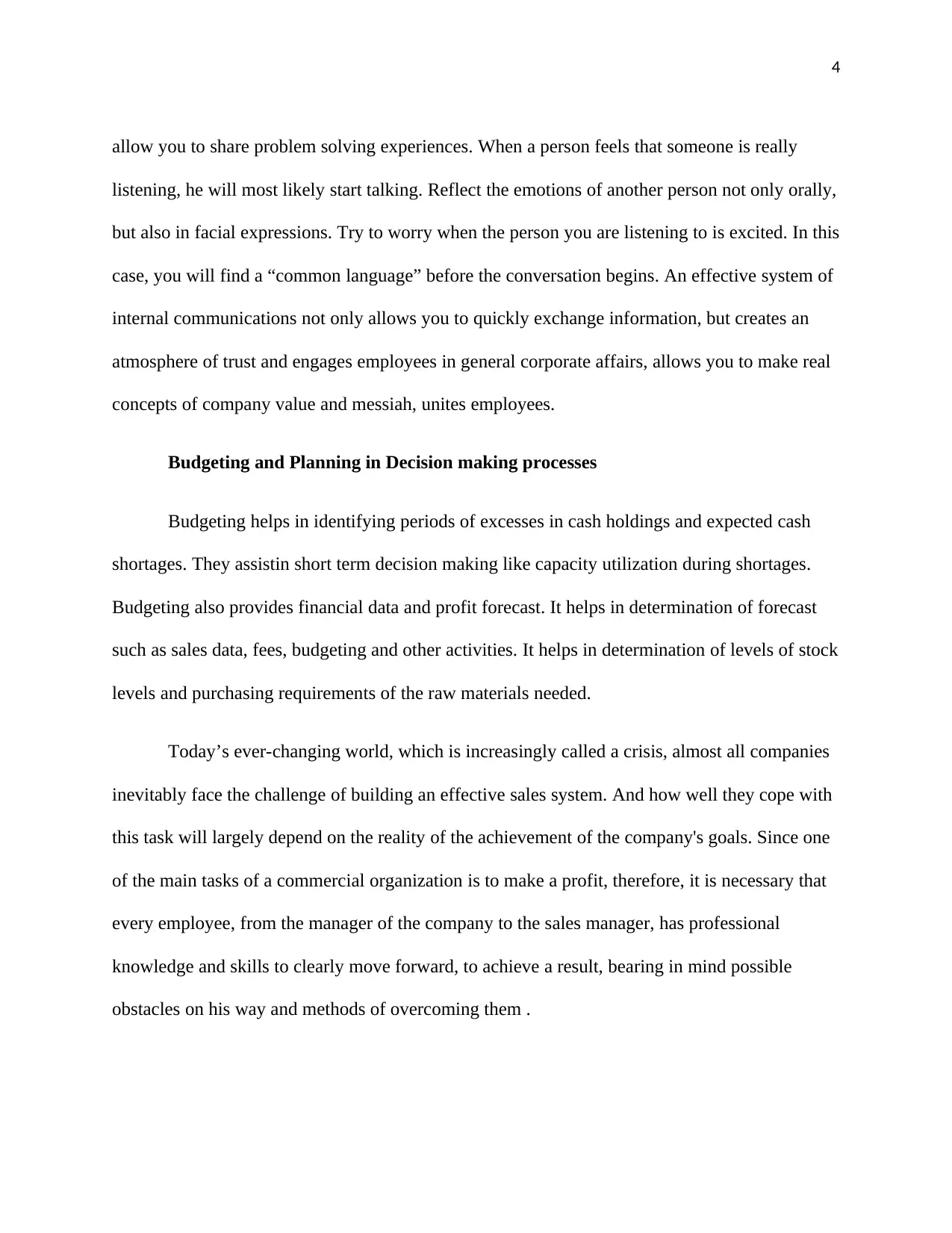
4
allow you to share problem solving experiences. When a person feels that someone is really
listening, he will most likely start talking. Reflect the emotions of another person not only orally,
but also in facial expressions. Try to worry when the person you are listening to is excited. In this
case, you will find a “common language” before the conversation begins. An effective system of
internal communications not only allows you to quickly exchange information, but creates an
atmosphere of trust and engages employees in general corporate affairs, allows you to make real
concepts of company value and messiah, unites employees.
Budgeting and Planning in Decision making processes
Budgeting helps in identifying periods of excesses in cash holdings and expected cash
shortages. They assistin short term decision making like capacity utilization during shortages.
Budgeting also provides financial data and profit forecast. It helps in determination of forecast
such as sales data, fees, budgeting and other activities. It helps in determination of levels of stock
levels and purchasing requirements of the raw materials needed.
Today’s ever-changing world, which is increasingly called a crisis, almost all companies
inevitably face the challenge of building an effective sales system. And how well they cope with
this task will largely depend on the reality of the achievement of the company's goals. Since one
of the main tasks of a commercial organization is to make a profit, therefore, it is necessary that
every employee, from the manager of the company to the sales manager, has professional
knowledge and skills to clearly move forward, to achieve a result, bearing in mind possible
obstacles on his way and methods of overcoming them .
allow you to share problem solving experiences. When a person feels that someone is really
listening, he will most likely start talking. Reflect the emotions of another person not only orally,
but also in facial expressions. Try to worry when the person you are listening to is excited. In this
case, you will find a “common language” before the conversation begins. An effective system of
internal communications not only allows you to quickly exchange information, but creates an
atmosphere of trust and engages employees in general corporate affairs, allows you to make real
concepts of company value and messiah, unites employees.
Budgeting and Planning in Decision making processes
Budgeting helps in identifying periods of excesses in cash holdings and expected cash
shortages. They assistin short term decision making like capacity utilization during shortages.
Budgeting also provides financial data and profit forecast. It helps in determination of forecast
such as sales data, fees, budgeting and other activities. It helps in determination of levels of stock
levels and purchasing requirements of the raw materials needed.
Today’s ever-changing world, which is increasingly called a crisis, almost all companies
inevitably face the challenge of building an effective sales system. And how well they cope with
this task will largely depend on the reality of the achievement of the company's goals. Since one
of the main tasks of a commercial organization is to make a profit, therefore, it is necessary that
every employee, from the manager of the company to the sales manager, has professional
knowledge and skills to clearly move forward, to achieve a result, bearing in mind possible
obstacles on his way and methods of overcoming them .
Paraphrase This Document
Need a fresh take? Get an instant paraphrase of this document with our AI Paraphraser
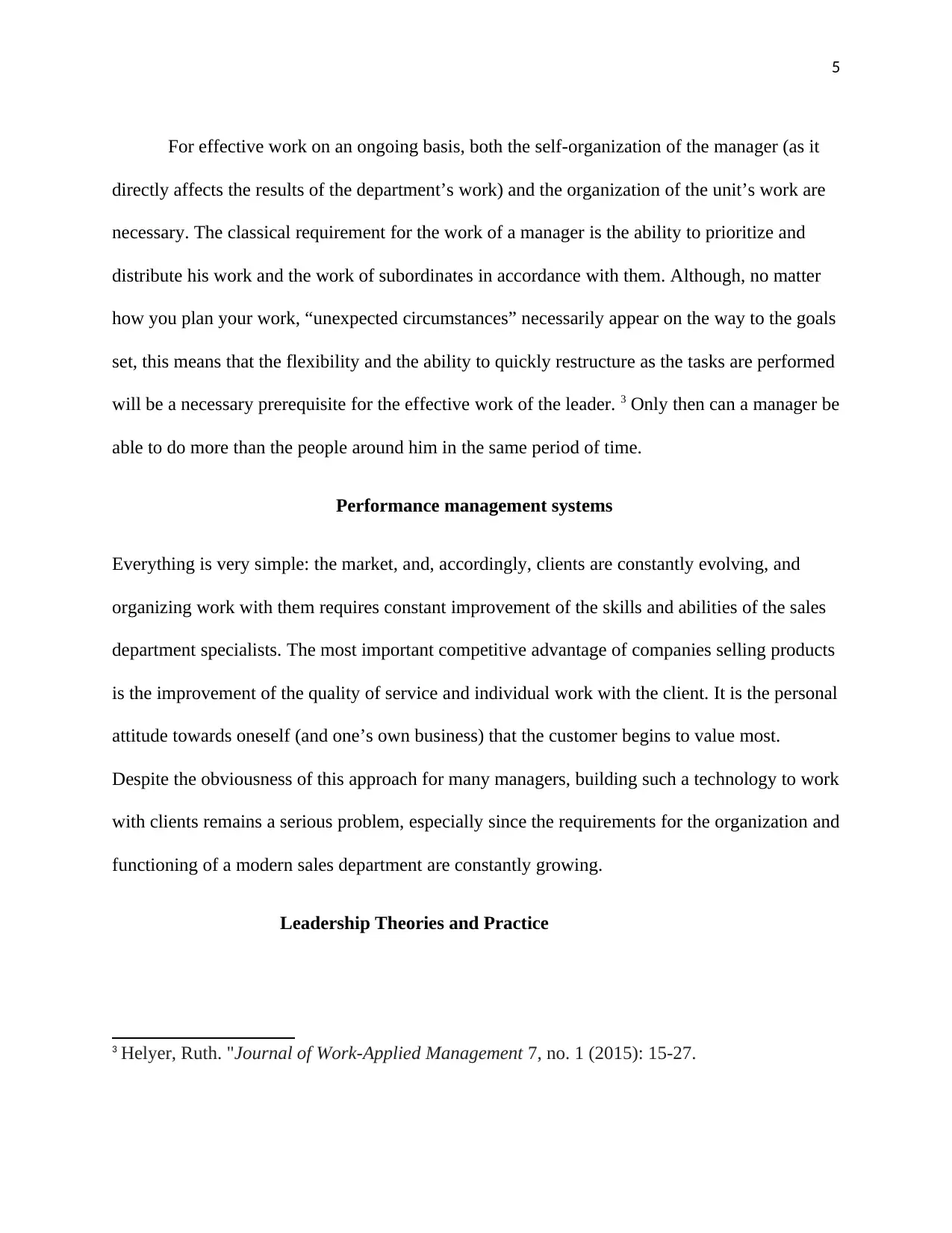
5
For effective work on an ongoing basis, both the self-organization of the manager (as it
directly affects the results of the department’s work) and the organization of the unit’s work are
necessary. The classical requirement for the work of a manager is the ability to prioritize and
distribute his work and the work of subordinates in accordance with them. Although, no matter
how you plan your work, “unexpected circumstances” necessarily appear on the way to the goals
set, this means that the flexibility and the ability to quickly restructure as the tasks are performed
will be a necessary prerequisite for the effective work of the leader. 3 Only then can a manager be
able to do more than the people around him in the same period of time.
Performance management systems
Everything is very simple: the market, and, accordingly, clients are constantly evolving, and
organizing work with them requires constant improvement of the skills and abilities of the sales
department specialists. The most important competitive advantage of companies selling products
is the improvement of the quality of service and individual work with the client. It is the personal
attitude towards oneself (and one’s own business) that the customer begins to value most.
Despite the obviousness of this approach for many managers, building such a technology to work
with clients remains a serious problem, especially since the requirements for the organization and
functioning of a modern sales department are constantly growing.
Leadership Theories and Practice
3 Helyer, Ruth. "Journal of Work-Applied Management 7, no. 1 (2015): 15-27.
For effective work on an ongoing basis, both the self-organization of the manager (as it
directly affects the results of the department’s work) and the organization of the unit’s work are
necessary. The classical requirement for the work of a manager is the ability to prioritize and
distribute his work and the work of subordinates in accordance with them. Although, no matter
how you plan your work, “unexpected circumstances” necessarily appear on the way to the goals
set, this means that the flexibility and the ability to quickly restructure as the tasks are performed
will be a necessary prerequisite for the effective work of the leader. 3 Only then can a manager be
able to do more than the people around him in the same period of time.
Performance management systems
Everything is very simple: the market, and, accordingly, clients are constantly evolving, and
organizing work with them requires constant improvement of the skills and abilities of the sales
department specialists. The most important competitive advantage of companies selling products
is the improvement of the quality of service and individual work with the client. It is the personal
attitude towards oneself (and one’s own business) that the customer begins to value most.
Despite the obviousness of this approach for many managers, building such a technology to work
with clients remains a serious problem, especially since the requirements for the organization and
functioning of a modern sales department are constantly growing.
Leadership Theories and Practice
3 Helyer, Ruth. "Journal of Work-Applied Management 7, no. 1 (2015): 15-27.
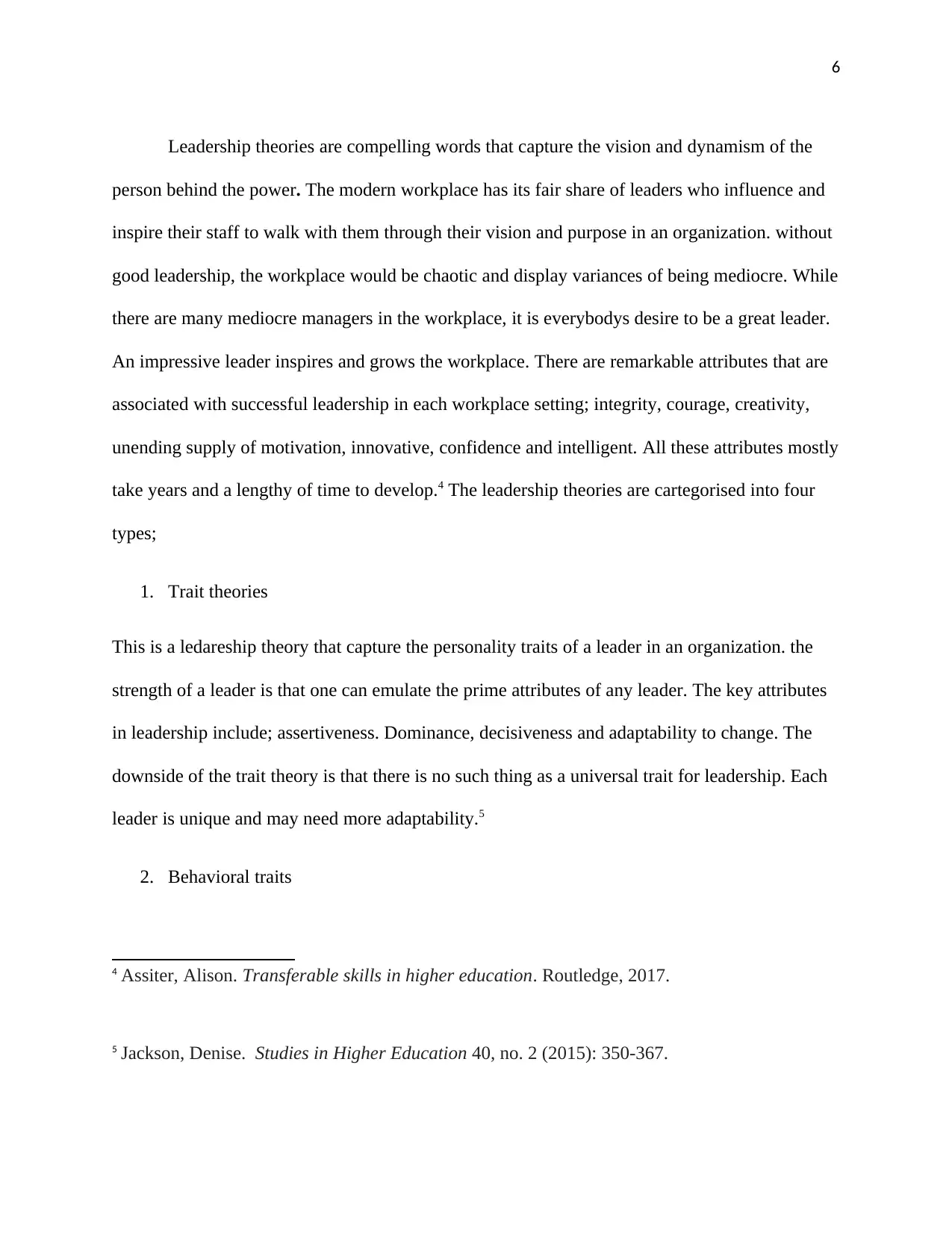
6
Leadership theories are compelling words that capture the vision and dynamism of the
person behind the power. The modern workplace has its fair share of leaders who influence and
inspire their staff to walk with them through their vision and purpose in an organization. without
good leadership, the workplace would be chaotic and display variances of being mediocre. While
there are many mediocre managers in the workplace, it is everybodys desire to be a great leader.
An impressive leader inspires and grows the workplace. There are remarkable attributes that are
associated with successful leadership in each workplace setting; integrity, courage, creativity,
unending supply of motivation, innovative, confidence and intelligent. All these attributes mostly
take years and a lengthy of time to develop.4 The leadership theories are cartegorised into four
types;
1. Trait theories
This is a ledareship theory that capture the personality traits of a leader in an organization. the
strength of a leader is that one can emulate the prime attributes of any leader. The key attributes
in leadership include; assertiveness. Dominance, decisiveness and adaptability to change. The
downside of the trait theory is that there is no such thing as a universal trait for leadership. Each
leader is unique and may need more adaptability.5
2. Behavioral traits
4 Assiter, Alison. Transferable skills in higher education. Routledge, 2017.
5 Jackson, Denise. Studies in Higher Education 40, no. 2 (2015): 350-367.
Leadership theories are compelling words that capture the vision and dynamism of the
person behind the power. The modern workplace has its fair share of leaders who influence and
inspire their staff to walk with them through their vision and purpose in an organization. without
good leadership, the workplace would be chaotic and display variances of being mediocre. While
there are many mediocre managers in the workplace, it is everybodys desire to be a great leader.
An impressive leader inspires and grows the workplace. There are remarkable attributes that are
associated with successful leadership in each workplace setting; integrity, courage, creativity,
unending supply of motivation, innovative, confidence and intelligent. All these attributes mostly
take years and a lengthy of time to develop.4 The leadership theories are cartegorised into four
types;
1. Trait theories
This is a ledareship theory that capture the personality traits of a leader in an organization. the
strength of a leader is that one can emulate the prime attributes of any leader. The key attributes
in leadership include; assertiveness. Dominance, decisiveness and adaptability to change. The
downside of the trait theory is that there is no such thing as a universal trait for leadership. Each
leader is unique and may need more adaptability.5
2. Behavioral traits
4 Assiter, Alison. Transferable skills in higher education. Routledge, 2017.
5 Jackson, Denise. Studies in Higher Education 40, no. 2 (2015): 350-367.
⊘ This is a preview!⊘
Do you want full access?
Subscribe today to unlock all pages.

Trusted by 1+ million students worldwide
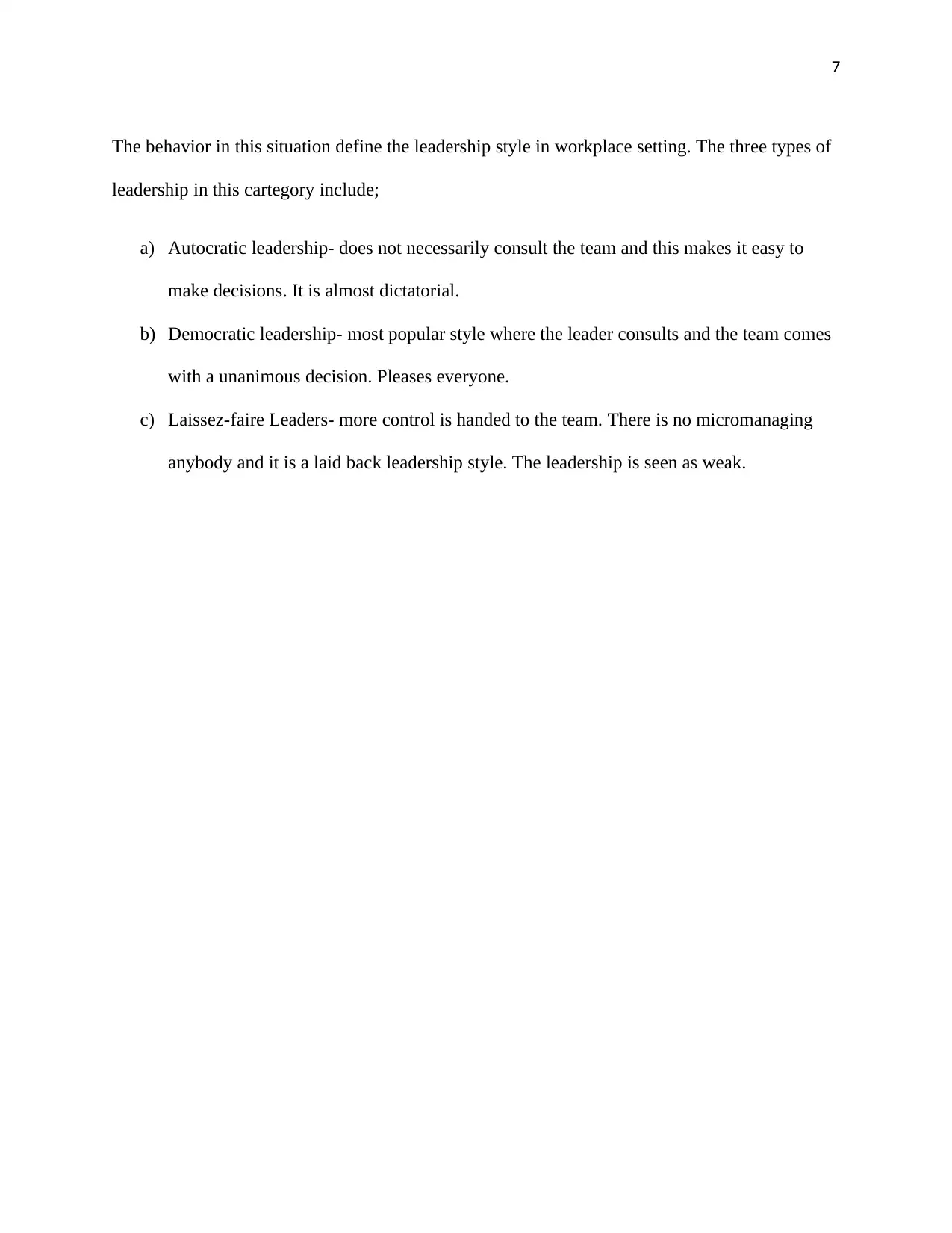
7
The behavior in this situation define the leadership style in workplace setting. The three types of
leadership in this cartegory include;
a) Autocratic leadership- does not necessarily consult the team and this makes it easy to
make decisions. It is almost dictatorial.
b) Democratic leadership- most popular style where the leader consults and the team comes
with a unanimous decision. Pleases everyone.
c) Laissez-faire Leaders- more control is handed to the team. There is no micromanaging
anybody and it is a laid back leadership style. The leadership is seen as weak.
The behavior in this situation define the leadership style in workplace setting. The three types of
leadership in this cartegory include;
a) Autocratic leadership- does not necessarily consult the team and this makes it easy to
make decisions. It is almost dictatorial.
b) Democratic leadership- most popular style where the leader consults and the team comes
with a unanimous decision. Pleases everyone.
c) Laissez-faire Leaders- more control is handed to the team. There is no micromanaging
anybody and it is a laid back leadership style. The leadership is seen as weak.
Paraphrase This Document
Need a fresh take? Get an instant paraphrase of this document with our AI Paraphraser
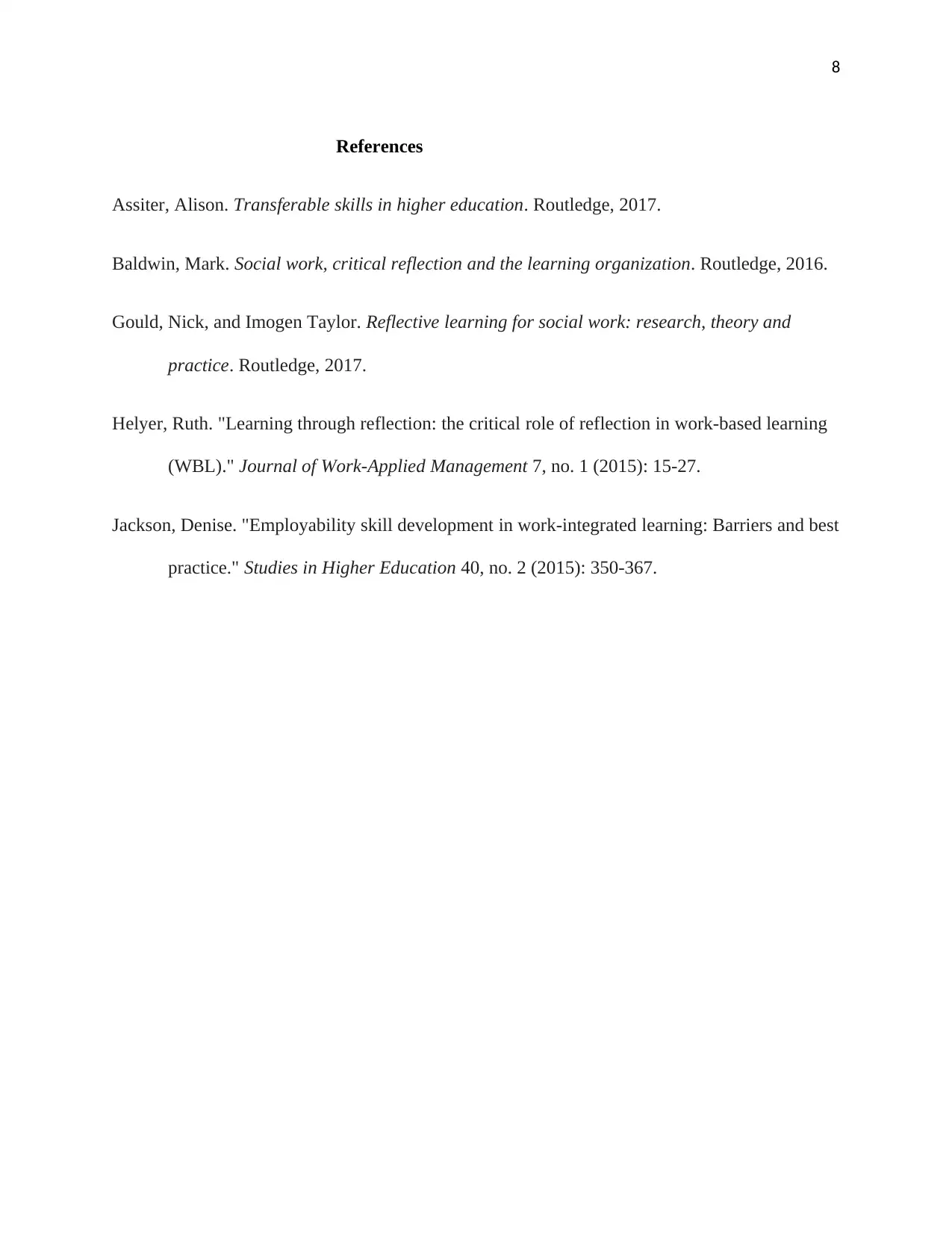
8
References
Assiter, Alison. Transferable skills in higher education. Routledge, 2017.
Baldwin, Mark. Social work, critical reflection and the learning organization. Routledge, 2016.
Gould, Nick, and Imogen Taylor. Reflective learning for social work: research, theory and
practice. Routledge, 2017.
Helyer, Ruth. "Learning through reflection: the critical role of reflection in work-based learning
(WBL)." Journal of Work-Applied Management 7, no. 1 (2015): 15-27.
Jackson, Denise. "Employability skill development in work-integrated learning: Barriers and best
practice." Studies in Higher Education 40, no. 2 (2015): 350-367.
References
Assiter, Alison. Transferable skills in higher education. Routledge, 2017.
Baldwin, Mark. Social work, critical reflection and the learning organization. Routledge, 2016.
Gould, Nick, and Imogen Taylor. Reflective learning for social work: research, theory and
practice. Routledge, 2017.
Helyer, Ruth. "Learning through reflection: the critical role of reflection in work-based learning
(WBL)." Journal of Work-Applied Management 7, no. 1 (2015): 15-27.
Jackson, Denise. "Employability skill development in work-integrated learning: Barriers and best
practice." Studies in Higher Education 40, no. 2 (2015): 350-367.
1 out of 8
Related Documents
Your All-in-One AI-Powered Toolkit for Academic Success.
+13062052269
info@desklib.com
Available 24*7 on WhatsApp / Email
![[object Object]](/_next/static/media/star-bottom.7253800d.svg)
Unlock your academic potential
Copyright © 2020–2025 A2Z Services. All Rights Reserved. Developed and managed by ZUCOL.





